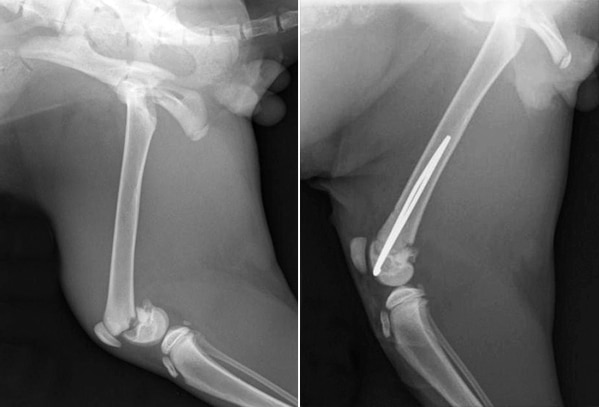
Unfortunately, as in people, fractures (broken bones) occur commonly in dogs and cats. There is a huge variety of different types of fractures, and these all have different treatments and carry different outlooks. Although having a fracture can be very traumatic for both pet and owner, the good news is that, with the correct treatment, most fractures in dogs and cats will heal well and most animals can regain normal use of their limbs (legs).
What can be done to treat a fracture?
Many fractures occur as a result of significant trauma, such as being hit by a car, and in these patients it is important that any life-threatening injuries are recognised and managed before treating the fracture which can generally be attended to less urgently. Investigations, such as X-rays, ultrasonography and blood tests, may be necessary in order to detect possible chest, abdominal and brain or spinal damage.
Depending on the type of fracture, different forms of treatment might be recommended. Initially, X-rays or a CT scan are performed to assess the broken bone and plan the treatment. Some fractures, especially in very young animals, can be treated using fibreglass casts. However, unlike the situation in humans, a dog or cat cannot be relied on to rest the limb properly, and any bandaging has the potential to cause serious complications. As a result, most animals are best treated with an operation. This allows the broken bones to be re-aligned and stabilised. Options for stabilising the bones include bone plates and screws, pins that are placed inside the bone, or external frames that are connected to the bone using pins going through the skin. Some fractures are relatively straightforward to manage and others are very complex, necessitating considerable orthopaedic instrumentation, implants and expertise.
Following surgery, most animals are very comfortable and are able to walk relatively normally within a few days. The problems seen with fibreglass casts, such as joint stiffness and muscle wastage, are largely avoided by performing appropriate fracture surgery.
What aftercare is needed following fracture surgery?
The aftercare for a pet with a broken bone is very variable and depends on the type of fracture, the type of operation that has been performed and the nature of the patient. Although most pets can be allowed to exercise almost immediately following surgery, it is important that unrestricted activity such as running or jumping is avoided. Some dogs and cats need to be restricted to a pen or a small room at times when they are not supervised. Physiotherapy and hydrotherapy may be recommended as part of the rehabilitation programme. In most cases we re-examine fracture patients six to eight weeks after surgery. Once an X-ray has shown the broken bone has healed, normal activity can usually be resumed.
What are the risks and complications associated with fracture surgery?
Despite best efforts, any fracture surgery can carry a risk of problems and complications. These can include infection, poor bone healing and implant breakage. Fortunately, in experienced hands these complications are uncommon, and the vast majority of pets will have an uneventful recovery. Fractures involving joints can lead to osteoarthritis which may require long term management, although in many animals this does not cause any significant problems. All aspects of your pet’s care, including the risk of complications, will be discussed in detail during your initial consultation with the orthopaedic surgeon, before any treatment is started.
What is the outlook following fracture surgery?
With correct planning and in the hands of experienced surgeons, the outlook for healing of most fractures is very good. The majority of animals can regain excellent use of their broken limb and can enjoy a normal quality of life.

Pelvic fracture in a Labrador Retriever repaired with a bone plate and screws

Multiple fractures of the femur in a Spaniel repaired with a plate, screws and pins

Fracture of the end of the femur in a puppy repaired with two pins

Tibial fracture in a puppy repaired with an external skeletal fixator
We are always happy to discuss any aspects of a case with you or your vet prior to referral. If you have any questions or concerns please contact us.
Arranging a referral for your pet
If you would like to refer your pet to see one of our Specialists please visit our Arranging a Referral page.